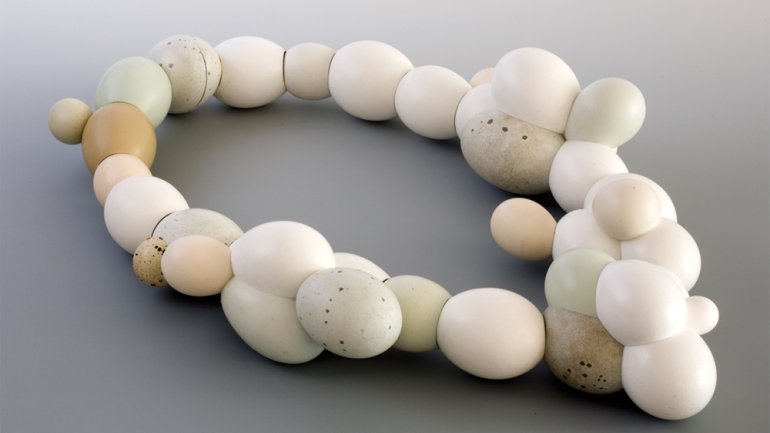Pelts and Armor
Pelts and Armor
Skins and other outer coatings offer glimpses into character, whether through wrinkles and laugh lines, cuts and scrapes, or weathered wear and tear. It’s amazing what scratching the surface can reveal.
What happens when you form a wet cowhide over a chair mold? If it’s Niels van Eijk’s cow chair, you get a dried cowhide that supports the weight of a sitter. With his earthy experiment, the Netherlands-based designer, along with partner Miriam van der Lubbe, continues to push boundaries with work for design houses such as Droog and Moooi.
With his Poultry Accumulus necklace (2009), New York-based, Uzbekistan-born jeweler Sergey Jivetin uses eggshells, with their sometimes solid, sometimes delicately speckled exteriors, to experiment with ideas about the fragility of natural materials and the intersection of the material world and more ethereal yearnings.
Ceramist Ron Nagle layers glazes and automotive paint in his most recent work, producing a surface that alternates between dull and rough, smooth and shiny. The San Francisco artist’s thick, touchable surfaces raise the issue of tactility in an increasingly virtual world. A bonus: tongue-in-cheek names such as Gold, Frankencense, and Murder (2012).
Michael Ferris Jr. works larger than life. Toufic (detail, 2010), for example, cut off at mid-thigh, nonetheless stands more than 6 feet high. Using reclaimed wood and pigmented wood glue, the Bronx-based sculptor reveals the personality of his subjects in mesmerizing detail.
English artist Dionne Marshall starts with vegetable-tanned leather, then draws on it with a tattoo gun. She works the leather, too, tooling and embossing it to bring out the dimensions of the finished product in a way that’s really not possible with typical body art.
Richmond, Virginia-based Morgan Herrin’s material of choice, reclaimed construction-grade lumber, appears strikingly naturalistic. His hand-carved details reveal a decaying exterior that suggests the viscera beneath. Boudica (2013) references the Celtic queen who led a rebellion against the Roman Empire.
Lindsay Pichaske takes the surfaces of her ceramic creatures to another plane entirely. A visit to the cadaver lab in graduate school led the DC-area artist to experiment with just how much personality she could inject into a simple object with surface treatments. Today, her creatures have startlingly realistic features, such as The Jackal (2013), a carnivore covered in naturally molted, hand-dyed feathers.

